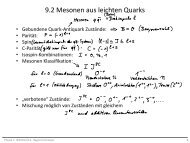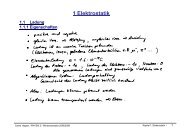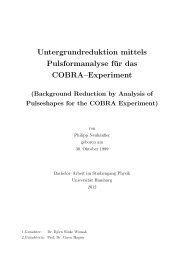Setup of a Drift Tube Muon Tracker and Calibration of Muon ...
Setup of a Drift Tube Muon Tracker and Calibration of Muon ...
Setup of a Drift Tube Muon Tracker and Calibration of Muon ...
You also want an ePaper? Increase the reach of your titles
YUMPU automatically turns print PDFs into web optimized ePapers that Google loves.
Hits per Event - Plane 0N1000h_hit0Entries 2789Mean 3.81RMS 3.407Hits per Event - Plane 1N1600h_hit1Entries 3919Mean 3.241RMS 3.05180014001200600100040080060020040020000 2 4 6 8 10 12 14 16 18 20N hit00 2 4 6 8 10 12 14 16 18 20N hitFigure 5.13: Number <strong>of</strong> hits per event for both 2D planes. Events with no hits werecut from the data. On can clearly identify a peak at four hits per event, which isexpected from the layout <strong>of</strong> the detector. However, the distribution shows also eventswith more than ten hits. These are caused mainly by noise or multiple muon events.Hitmap after noise cut - Plane 0N hits908070605040302010h_hitmapc0Entries 5794Mean 46.26RMS 27.6500 10 20 30 40 50 60 70 80 90<strong>Tube</strong>Hitmap after noise cut - Plane 1N hits24022020018016014012010080604020h_hitmapc1Entries 7850Mean 38.1RMS 25.5700 10 20 30 40 50 60 70 80 90<strong>Tube</strong>Figure 5.14: Hit map <strong>of</strong> all tubes in the CMT. The peaks in the x − z-plane (plane1) can be explained by the poor trigger efficiency <strong>of</strong> trigger scintillators A <strong>and</strong> B.Therefore a cut <strong>of</strong> n hits > 0 is applied for each 2D plane.The number <strong>of</strong> hits per event is shown in Fig. 5.13. As expected, a peak atn hit = 4 is observed. However, the distributions show a rather long tail towardslarger values. A large number <strong>of</strong> hits can occur when a track with a steep inclinationcrosses the detector. However, this cannot explain the extent <strong>of</strong> the tail in thedistribution. By looking at single events, one finds that many <strong>of</strong> the events inquestion show fake hits probably occurring from cross talk <strong>and</strong> also δ electrons. Asecond cause for large values <strong>of</strong> n hit are multiple muon events, where there is anexpected average <strong>of</strong> eight hits per event (see also Fig.5.17).Fig. 5.14 shows the hit maps for both 2D planes. All tubes except tube 0 inmodule 1.0 seem to be working fine. However, instead <strong>of</strong> a homogeneous distribution,four distinct peaks can be seen for the same module. These are a hint for a systematicerror in the setup. The error source could be identified in a poor efficiency in some<strong>of</strong> the trigger scintillators, namely scintillators A <strong>and</strong> B (cf. Fig. 5.1). Due the thesegmentation <strong>of</strong> the trigger plane, the characteristic shapes occur. The (presumablywell working) trigger scintillators C <strong>and</strong> D are the small ones on the left facingthe x − z-plane. Hence, tubes located at small x show significantly more hits (cf.Fig. C.1 for a channel map <strong>of</strong> each tube). The peak maximum reduces slightlyfor each layer <strong>of</strong> tubes the further they are away from the scintillator, but it also81





